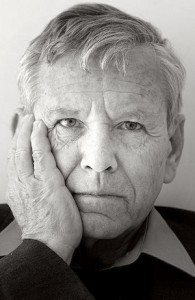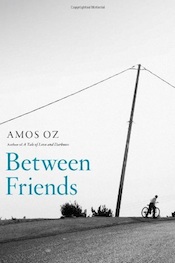In the early 1950s, at the age of 15, Amos Oz moved to Kibbutz Hulda in central Israel. Idealists at that time still celebrated the kibbutz as a new form of community that would transform human nature. But the reality was something else. In Between Friends (Mariner Books, 2013, translated from the Hebrew by Sondra Silverston), the acclaimed Israeli novelist takes us to a fictitious kibbutz in 1950s Israel called Yikhat to meet several characters that were part of that world.

With an eye for revealing details, Oz recreates a rich world of ordinary, well-meaning people with difficult pasts and passionate dreams. Their anxieties are not unique, stemming from tangled-up longings, failed relationships and unspoken thoughts. Their personal crises would not be out of place as part of daily life in any tightly knit community.
Oz, an acclaimed Israeli novelist who has been mentioned as a candidate for the Nobel Prize in literature, writes eight stories that are interconnected about the plain folks of the kibbutz – the gardener, schoolteacher, mechanic, electrician and others. They may have once believed they could change the world but, by the time we meet them, they are resigned to their quiet routines, which they undertake without complaint and, in some instances, with considerable pride. However, their emotional lives remain in turmoil, entangled in tussles “between friends.” A pervasive feeling of loneliness in the midst of neighbors they have known for years overshadows all other feelings.
Zvi Provisor is the first kibbutznik we meet. He is obsessed with reporting famines, earthquakes, plane crashes and other disasters from anywhere in the world. Most kibbutzniks dismiss him, with some affection, as the Angel of Death. Kibbutznik Luna Blank offers a sympathetic ear.
As their friendship grows, they meet in her room for coffee. One evening, she is, as Oz writes, so overwhelmed with compassion that she suddenly takes his hand and holds it to her breast.
“Zev trembled and pulled his hand back quickly, with a gesture that was almost violent. His eyes blinked frantically. Never in his adult life had he touched another person intentionally, and he went rigid whenever he was touched … a short time later, he stood up and left.”
In an interview with Haaretz after the book was first published, Oz said he wanted to look at the loneliness in a society where there is supposedly no place for loneliness.
“In a few of the stories, a situation is portrayed of ‘almost touching’: people very nearly touch, but something blocks it. Like [‘The Creation of Adam,’] in the painting by Michelangelo, where finger almost touches finger.
“I am very curious about loneliness and grace, or a moment of grace amid loneliness, because that is a description of the human condition.
“The stories are set on a kibbutz, but they tell about universal situations, about the most basic forces in human existence, about loneliness, about love, about loss, about death, about desire, about forgoing and about longing. In fact, about the simple and profound matters, which no person is unfamiliar with.”

Not surprisingly, Oz portrays simple kibbutz life with some charm. Kibbutzniks translate Polish novels in their spare time and listen to classical music. Everyone takes his or her turn doing a shift in the dining hall.
Osnat is a quiet woman. She works all day alone in the laundry, beginning at 5:30 a.m. As we are introduced to her, Osnat’s partner Boaz has just told her that he has been in a relationship for eight months with another kibbutznik, the tall, slim Ariella Barash, who works in the chicken coop. Boaz has decided to move into Ariella’s apartment.
On Kibbutz Yikhat, the environment reinforces the characters that live there. Ariella has an old cat and young dog that treat each other much like the kibbutzniks relate to the other kibbutzniks. The young dog was frightened of the cat and would politely give it a wide berth, Oz writes. The old cat would ignore the dog and walk past as if the dog were invisible. Boaz shows some affection for the young dog. “But if the cat should jump onto his lap asking for affection, he heaves him off with such disgust that I cringe,” Ariella writes in a note to Osnat, several days after Boaz has moved in with his new love.
We are not told about Osnat and Ariella’s relationship before Boaz arrived on the scene. However, after Boaz starts living with Ariella,
the two women exchange notes. Osnat, who is not angry about the break-up, continues to worry about Boaz’s health. Ariella tries to justify her relationship with another woman’s partner.
With Oz’s poetic style, the chapter ends with a gentle breeze blowing, “just enough to cool a cup of tea.” A solitary figure abandoned by her lover, Osnat listens to “light music” on the radio and reads a book before going to bed. “Her nights are dreamless now and she wakes before the alarm clock rings. The pigeons wake her.”
Oz is well known as an outspoken advocate of a two-state solution to the Israeli-Palestinian conflict. Middle East tensions and Israeli politics pop up only as a backdrop to the kibbutzniks’ lives. He writes about the effect of events on the kibbutzniks, not much about the events themselves. The characters mention threats to the kibbutz but without any discussion of events.
We learn that Nahum’s wife was killed in a retaliatory raid and that his son was killed during an army incursion into the village of Deir al Nashaf. We are told nothing more about these confrontations. However, we can feel the impact of these tragedies when Nahum struggles as his 17-year-old daughter Edna, a few months before going into the army, moves in with David Dagan, a teacher her father’s age, as well as a longtime friend of her father.
David is a devout Marxist who speaks with authority about ideological issues as well as matters of everyday life. Nahum is an unsure father who does not have the confidence to confront David over the inappropriate affair.
Oz is extremely effective in bringing the reader right into the room with the characters he creates. We are in Nahum’s electrician’s workshop, where he sits, day after day, “shoulders stooped, glasses sliding down his nose, working on appliances in need of repair: electric kettles, radios, fans.”
We are taken to the doorstep of Edna’s dorm room, where Nahum has gone to bring a sweater she has left at his apartment. He listens to the music coming from the room, “a light, lengthy étude that repeated itself in a melancholy way.”
In later chapters, we hear the gossip about kibbutz secretary Yoav Carni. We see the futile efforts of Henia Kalisch as she tries to arrange for kibbutz support for her son to study abroad. Despite whom we meet, there is no escaping the sadness and loneliness that permeates the lives of so many people on Kibbutz Yikhat.
Our kibbutz visit ends with a funeral for shoemaker Martin Vandenberg, an enthusiastic advocate of Esperanto, the universal language that was to unify humanity.
Osnat is the last person to leave the cemetery. She lingers, feeling a sense of peace. In remarks that could be Oz reflecting on the entire book, Osnat feels as if this “hadn’t been a funeral, but a good satisfying conversation.”
Oz does not leave the kibbutz at that point, however. Osnat has a sudden desire to say more, one or two quiet words in Esperanto in tribute to Martin. “But she hadn’t had time to learn anything and she had no idea what to say.”
Media consultant Robert Matas, a former Globe and Mail journalist, still reads books. Between Friends is available at the Isaac Waldman Jewish Public Library. To reserve this book, or any other, call 604-257-5181 or email [email protected]. To view the online catalogue, visit jccgv.com and click on Isaac Waldman Library.
